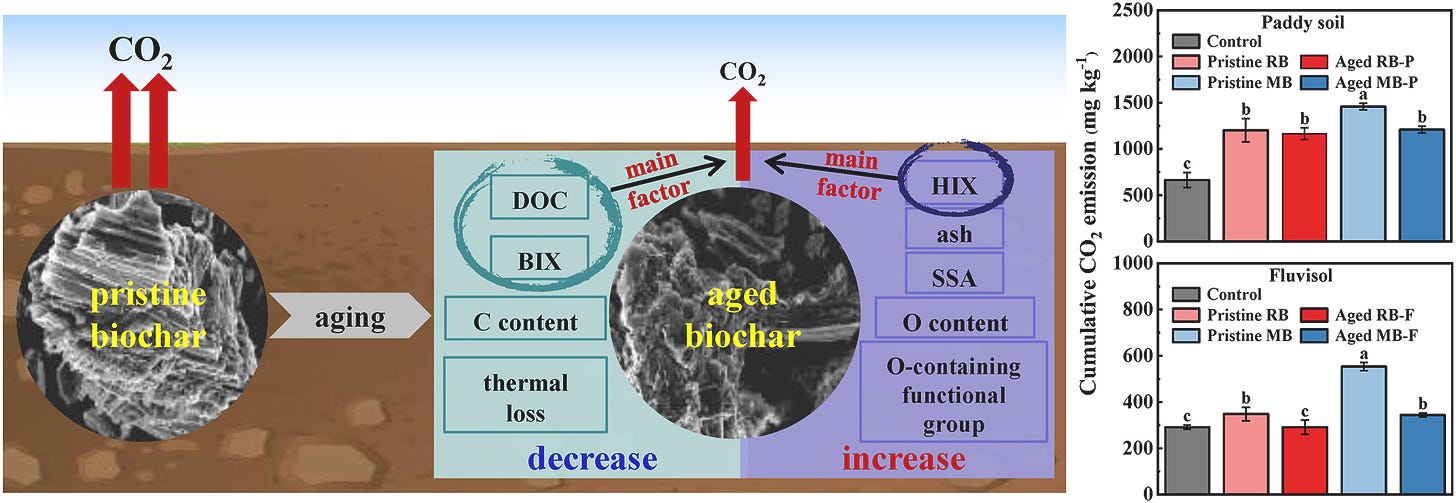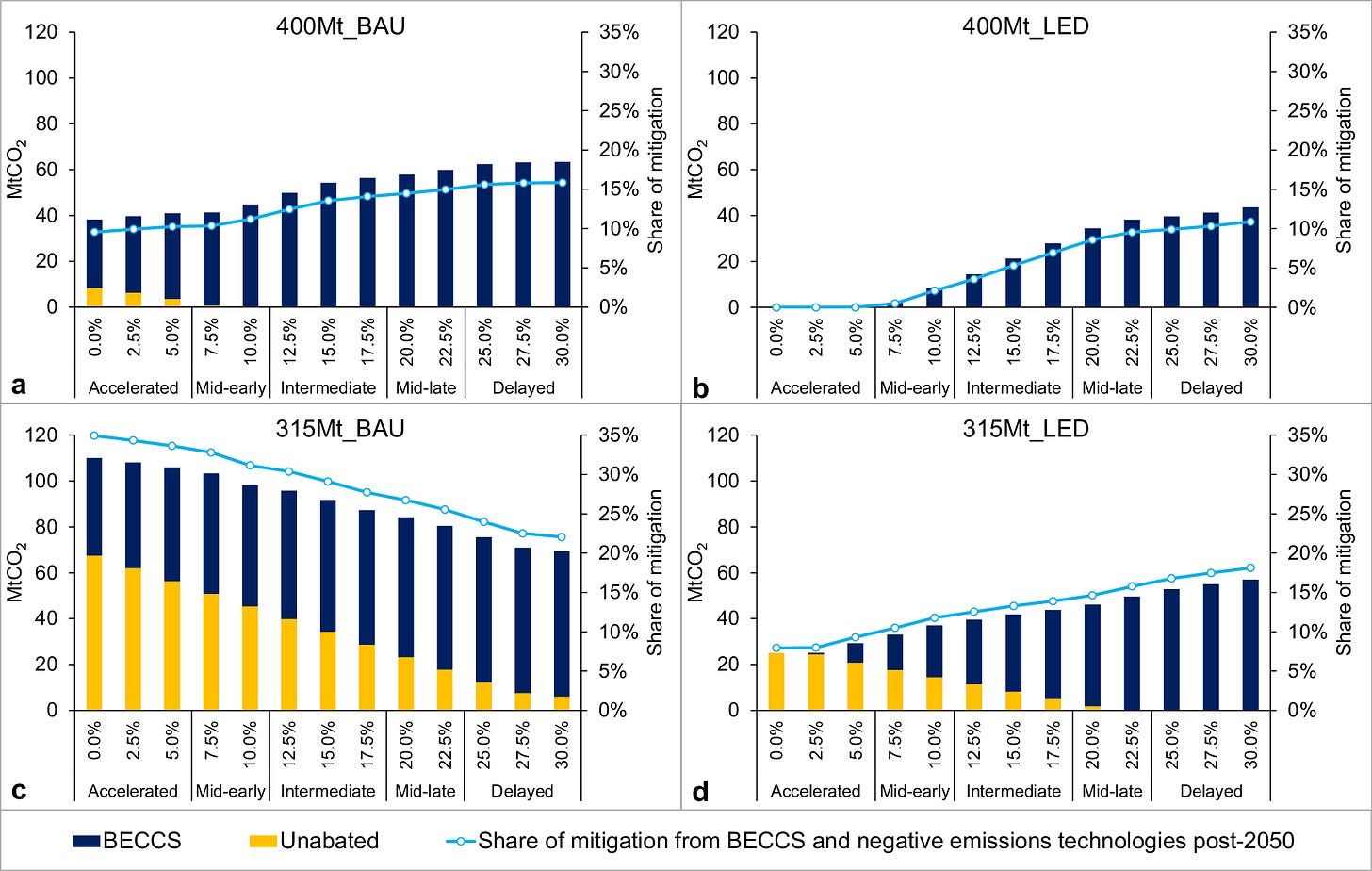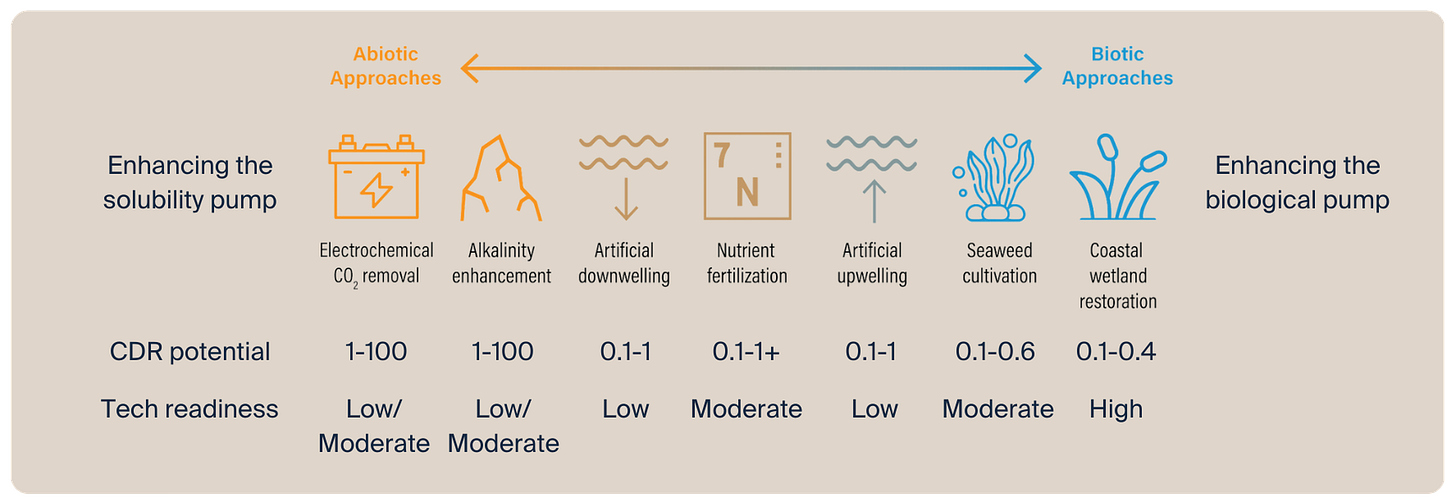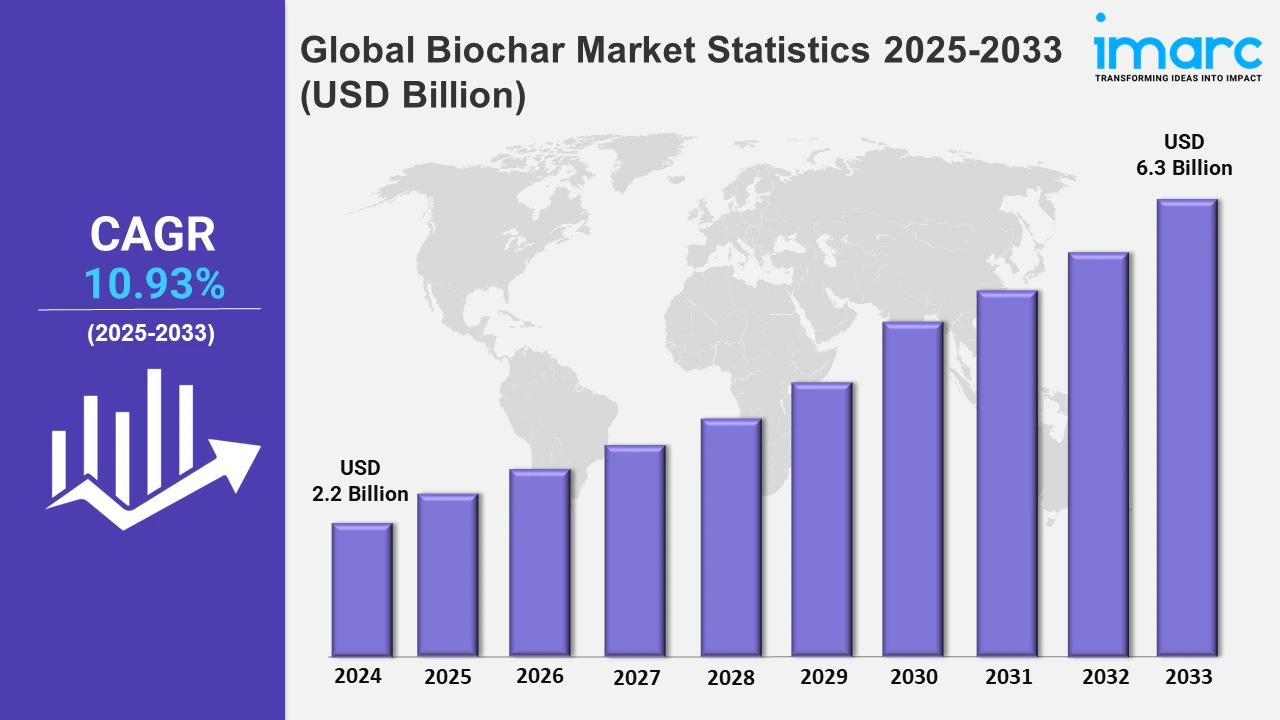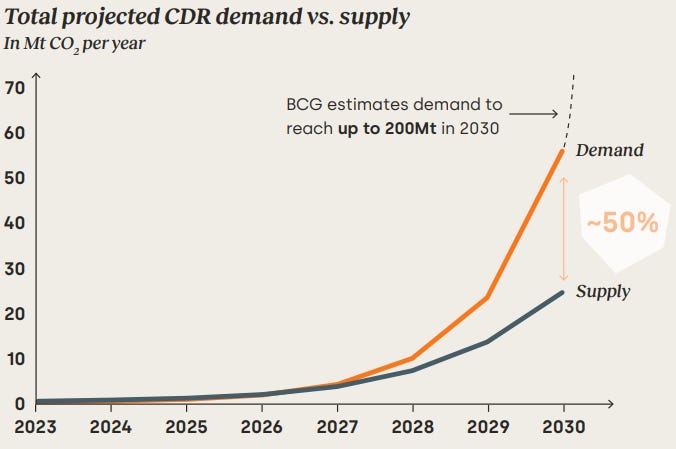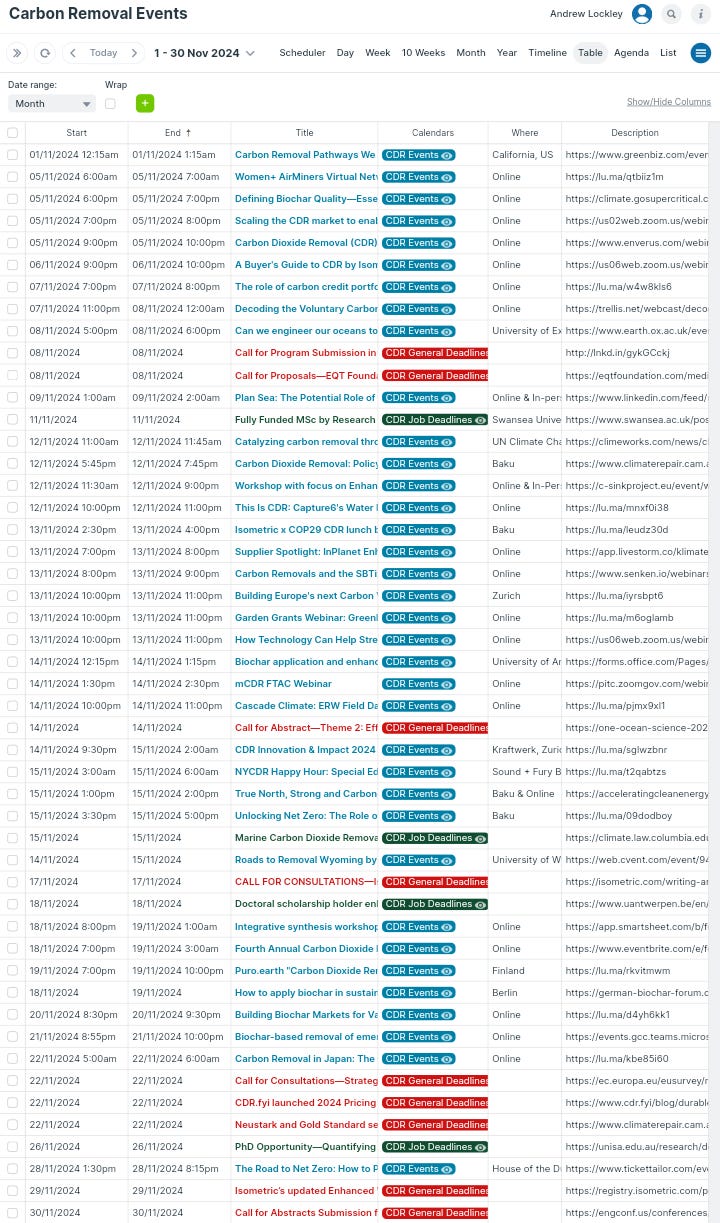CARBON REMOVAL WEEKLY SUMMARY (04 NOVEMBER - 10 NOVEMBER 2024)—WEEK#45
Links to recent scientific papers, web posts, upcoming events, job opportunities, podcasts, and event recordings, etc. on Carbon Dioxide Removal Technology.
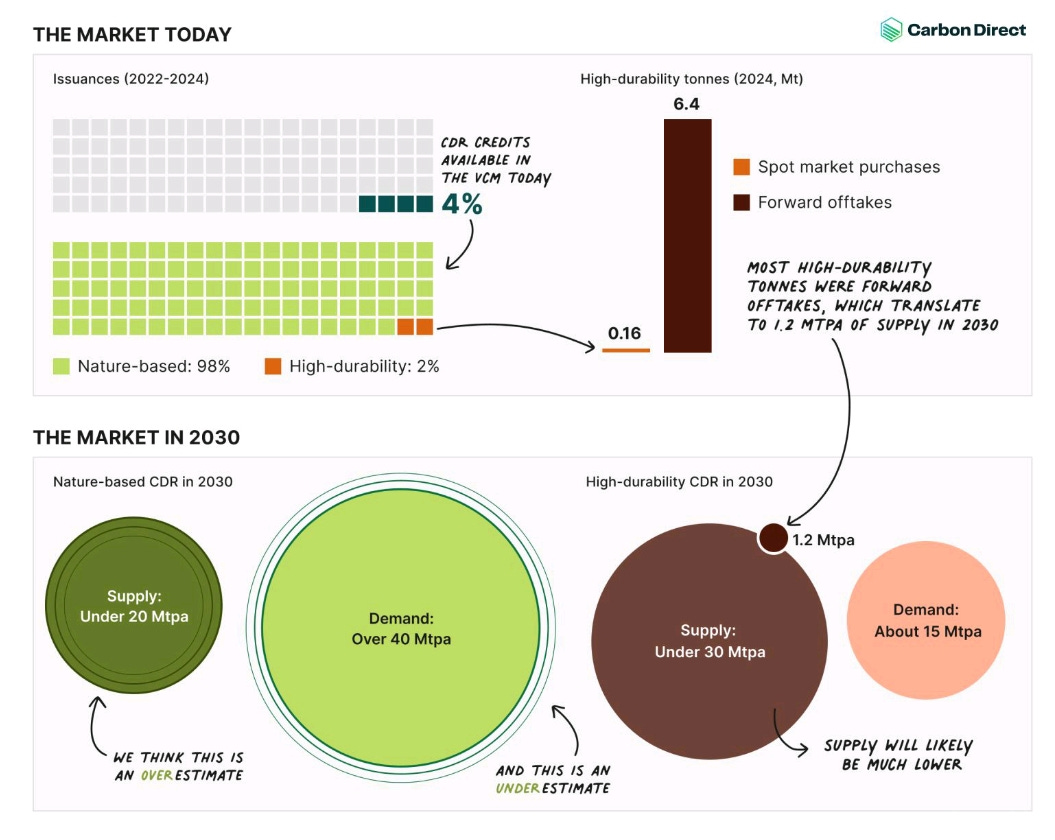
TABLE OF CONTENTS
1. Commercial News
2. Research Papers
3. Web Posts
4. Reports
5. Upcoming Events
6. Job Opportunities
7. Podcasts
8. YouTube Videos
9. Deadlines
Note: Click on the headings listed in the table of contents above to easily navigate to the sections you're interested in.
COMMERCIAL NEWS
Amsterdam-based SeaO₂ secured over €2 million to advance carbon removal technology (EU Startups)
Artio raises £550k to pioneer insurance for carbon removal projects (Northern Leaders)
44.01 and ADNOC partnered to scale up carbon mineralisation in the UAE (44.01)
Prometheus Materials Awarded Role in $10M Department of Energy Grant for Carbon Dioxide Removal (CDR) in Cement and Concrete (PR Newswire)
Aggregate Industries partners with neustark to sink carbon into concrete (New Civil Engineer)
Exomad Green launched their new biochar facility in Riberalta, Bolivia, aiming to sequester 60,000 tonnes of CO₂ annually (LinkedIn)
Ulysses secured an oversubscribed $2M pre-seed round, led by Lowercarbon, to use robotic technology for restoring seagrass ecosystems in the U.S. and Australia (Tech Crunch)
BluSky Carbon Joint Venture Inks Binding LOI’s for Biochar Projects in Orlando and Tanzania (BluSky Carbon)
BeZero Carbon and Climate Impact X announced a partnership, under which BeZero Carbon’s ratings will be integrated into the CIX Exchange (BeZero)
The Carbon Removers announced its expansion into Denmark, where it will begin capturing and storing 4,650 tonnes of biogenic CO2 annually starting in 2026 (Invest in Denmark)
RESEARCH PAPERS
Estimating countries’ additional carbon accountability for closing the mitigation gap based on past and future emissions
Hahn, T., Morfeldt, J., Höglund, R., Karlsson, M., & Fetzer, I. (2024). Estimating countries’ additional carbon accountability for closing the mitigation gap based on past and future emissions. Nature Communications, 15(1), 9707.
Synopsis: This study proposes an "additional carbon accountability" indicator to measure countries' responsibility for emissions reduction and CO₂ removal beyond their own targets. By incorporating carbon debts since 1990 and future emissions based on national pathways, the indicator uses an equal per capita emissions approach to allocate accountability. Findings indicate that the carbon budget will be exceeded by 576 Gt CO₂ for a 1.5 °C target, with the U.S. and China having the highest accountability.
Field aging slows down biochar-mediated soil carbon dioxide emissions
Pan, Y., Yin, Y., Sharma, P., Zhu, S., & Shang, J. (2024). Field aging slows down biochar-mediated soil carbon dioxide emissions. Journal of Environmental Management, 370, 122811.
Synopsis: Biochar is widely used for soil carbon sequestration, yet its long-term effects on soil and CO₂ emissions are underexplored. This study examines rice and maize biochars in acidic paddy soil and alkaline fluvisol over one year. Analyses (SEM-EDS, FTIR, 3D-EEM, TG-DTG) showed aged biochars had greater surface area, structural degradation, and oxygen-containing functional groups, with decreased DOM fluorescence and increased thermal stability. Aged biochar improved short-term soil carbon sequestration and reduced CO₂ emissions, aiding soil carbon retention by enhancing DOM humification and reducing DOC release.
Fire weakens land carbon sinks before 1.5 °C
Burton, C. A., Kelley, D. I., Burke, E., Mathison, C., Jones, C. D., Betts, R. A., ... & Anderson, L. O. (2024). Fire weakens land carbon sinks before 1.5° C. Nature Geoscience, 1-7.
Synopsis: The Paris Agreement aims to limit global warming to 1.5°C, but models often overlook the feedback between fire, vegetation, and carbon, which are crucial for understanding ecosystem resilience. Using a coupled fire–vegetation model, this study shows that fire significantly impacts global carbon storage at 1.07°C above pre-industrial levels. Fire reduces the remaining carbon budget by 25 GtCO₂ for a 1.5°C limit and 64 GtCO₂ for 2.0°C. While limiting warming to 1.5°C is critical, many ecosystems are already facing significant changes.
Enhanced cation release via acid pretreatment for gigaton-scale geologic CO2 sequestration in basalt
Zhang, Q., Awolayo, A. N., Phelps, P. R., Vadsariya, S., Laureijs, C. T., Eisaman, M. D., & Tutolo, B. M. (2024). Enhanced cation release via acid pretreatment for gigaton-scale geologic CO2 sequestration in basalt. International Journal of Greenhouse Gas Control, 139, 104266.
Synopsis: Basalt-based CO₂ mineralization has the potential for gigaton-scale CO₂ sequestration but faces obstacles, including low cation release and pore-clogging clay formation. Using acids like HCl, a by-product of certain CO₂ removal processes, could enhance basalt reactivity, although the mechanisms in acidic conditions remain poorly understood. To bridge this gap, this study measured the dissolution rates of basaltic glass and crystalline basalt in mixed flow reactors across pH 0 to 9 and temperatures from 23 to 60 °C, with a focus on acidic conditions.
Mapping the global variation in the efficiency of ocean alkalinity enhancement for carbon dioxide removal
Zhou, M., Tyka, M. D., Ho, D. T., Yankovsky, E., Bachman, S., Nicholas, T., ... & Long, M. C. (2024). Mapping the global variation in the efficiency of ocean alkalinity enhancement for carbon dioxide removal. Nature Climate Change, 1-7.
Synopsis: To limit global warming to below 2°C by 2100, CO₂ removal from the atmosphere is essential, and ocean alkalinity enhancement (OAE) offers a scalable approach. However, incomplete air–sea CO₂ equilibration limits its efficiency. This study provides global maps of OAE efficiency, revealing two distinct equilibration phases: rapid surface equilibration and a slower phase due to re-emerging subducted alkalinity. Efficiency varies with latitude and release season, guiding OAE deployment. The study also quantifies CO₂ uptake patterns, crucial for regional OAE modeling.
A Review of Life Cycle Assessment Methods to Inform the Scale-Up of Carbon Dioxide Removal Interventions
Butnar, I., Lynch, J., Vetter, S., Gamaralalage, D., Tang, Y., McKechnie, J., ... & House, J. (2024). A Review of Life Cycle Assessment Methods to Inform the Scale‐Up of Carbon Dioxide Removal Interventions. Wiley Interdisciplinary Reviews: Energy and Environment, 13(6), e540.
Synopsis: Life Cycle Assessment (LCA) methods are increasingly applied to guide policy decisions for scaling sustainable carbon dioxide removal (CDR). This review examines CDR LCA case studies based on three criteria: cross-comparability of CDR assessments, evaluation of CDR’s climatic benefits, and assessment of broader co-benefits and impacts. Findings show that diverse, often attributional, methods limit comparability and overlook scale-up implications. To improve CDR LCAs, clearer study scopes, consistent functional units, comprehensive system boundaries, and explicit baselines are needed. Time-dependent data and a full life cycle approach should inform assessments, emphasizing climate merits, co-benefits, and trade-offs. Consequential analyses and metric comparisons can support sustainable CDR scale-up.
Tree planting is no climate solution at northern high latitudes
Kristensen, J. Å., Barbero-Palacios, L., Barrio, I. C., Jacobsen, I. B., Kerby, J. T., López-Blanco, E., ... & Macias-Fauria, M. (2024). Tree planting is no climate solution at northern high latitudes. Nature Geoscience, 17(11), 1087-1092.
Synopsis: Tree planting is often promoted as a climate change mitigation strategy due to its ability to store carbon in biomass. However, according to this study, in high-latitude regions like the boreal and Arctic, it can be counterproductive. Tree planting reduces albedo, causing net warming, and disrupts soil carbon pools, which store the majority of carbon in these cold ecosystems. Despite economic incentives, this approach is not effective for climate mitigation in these regions. A systems-oriented approach that considers all relevant Earth system processes is needed to avoid ineffective climate strategies.
Weakening of global terrestrial carbon sequestration capacity under increasing intensity of warm extremes
Yuan, X., Chen, X., Ochege, F. U., Hamdi, R., Tabari, H., Li, B., ... & Luo, G. (2024). Weakening of global terrestrial carbon sequestration capacity under increasing intensity of warm extremes. Nature Ecology & Evolution, 1-10.
Synopsis: The net ecosystem exchange (NEE), a key measure of terrestrial carbon sequestration, has fluctuated significantly due to climate change, with warm extremes weakening its capacity. Analysis of multiple datasets over 40 years shows that warm extremes, especially in tropical regions, have decreased gross primary productivity more than terrestrial ecosystem respiration. This shift from temperature or soil moisture control to vapor pressure deficit control, driven by warming extremes, threatens global carbon sequestration, highlighting the need for attention to future climate projections.
Questionable devices: Applying a large language model to deliberate carbon removal
Waller, L., Moats, D., Cox, E., & Bellamy, R. (2024). Questionable devices: Applying a large language model to deliberate carbon removal. Environmental Science & Policy, 162, 103940.
Synopsis: This paper explores a device-centered approach to deliberation, using ChatGPT in workshops focused on carbon dioxide removal methods. The study introduces the concept of a "questionable" device to highlight the informational unpredictability ChatGPT brought to discussions. While the tool was often used unquestioningly, it sparked critiques on issues like expert resources, issue definitions, and social classifications. The paper concludes by reflecting on the need for informed deliberation in the evolving field of carbon removal.
An updated synthesis of ocean total alkalinity and dissolved inorganic carbon measurements from 1993 to 2023: the SNAPO-CO2-v2 dataset
Metzl, N., Fin, J., Lo Monaco, C., Mignon, C., Alliouane, S., Bombled, B., ... & Wimart-Rousseau, C. (2024). An updated synthesis of ocean total alkalinity and dissolved inorganic carbon measurements from 1993 to 2023: the SNAPO-CO2-v2 dataset. Earth System Science Data Discussions, 2024, 1-39.
Synopsis: In this study, the SNAPO-CO2 database, updated with 24,700 new data points from 2002 to 2023, now contains over 67,000 total alkalinity (AT) and dissolved inorganic carbon (CT) observations. These data, collected from various oceanic regions, provide crucial information for understanding the ocean carbon cycle, ocean acidification, and marine carbon removal. The dataset includes both surface and water column data from open oceans, coastal zones, and rivers, and can be used for regional or global studies, modeling, and carbon system analysis.
The potential of the BBNJ clearing house mechanism to enhance knowledge pluralism in marine carbon dioxide removal assessment
Boettcher, M., & Brent, K. The potential of the BBNJ clearing house mechanism to enhance knowledge pluralism in marine carbon dioxide removal assessment. Frontiers in Climate, 6, 1497476.
Synopsis: As global efforts towards net-zero emissions grow, marine carbon dioxide removal (mCDR) in the open ocean is gaining attention. However, many mCDR approaches are still in early development stages, raising questions about their assessment and governance. This paper explores the role of the newly established BBNJ Agreement in assessing and governing mCDR. It highlights how the Clearing House Mechanism (CHM) could support knowledge pluralism and offer a holistic assessment, while also addressing challenges in its implementation.
Accelerated Testing of PEI-Silica Sorbent Pellets for Direct Air Capture
Thakkar, H. V., Ruba, A. J., Matteson, J. A., Dugas, M. P., & Singh, R. P. (2024). Accelerated Testing of PEI-Silica Sorbent Pellets for Direct Air Capture. ACS Omega.
Synopsis: Amine-based sorbents, like polyethylenimine (PEI), are promising for direct air capture of CO2 but suffer from degradation, limiting large-scale deployment. This study evaluates a novel synthesis method for PEI-sorbent powder, which significantly reduces toxic solvent use. It also examines sorbent degradation under various conditions, finding that degradation is rapid under high temperatures and oxygen. Dry CO2 accelerates degradation more than wet CO2 or inert environments, revealing the challenges for long-term stability in industrial DAC conditions.
Opportunities for carbon sequestration from removing or intensifying pasture-based beef production
Hayek, M. N., Piipponen, J., Kummu, M., Resare Sahlin, K., McClelland, S. C., & Carlson, K. (2024). Opportunities for carbon sequestration from removing or intensifying pasture-based beef production. Proceedings of the National Academy of Sciences, 121(46), e2405758121.
Synopsis: Pastures, covering one-third of Earth's surface, support ruminant livestock, but removing livestock can help mitigate climate change by sequestering carbon in regrowing vegetation and recovering soils. This study evaluates the tradeoff between climate benefits and food production, finding that removing beef cattle from high-carbon intensity pastures could sequester 34 GtC, more than global fossil CO2 emissions from 2021-2023, with only a minor loss in beef production. The carbon opportunity intensity metric can guide ecosystem restoration while minimizing food loss.
Carbon removal for a just transition
Nawaz, S., McLaren, D., Caggiano, H., Hudson, A. D., & Scott-Buechler, C. (2024). Carbon removal for a just transition. Climate Policy, 1-12.
Synopsis: The need for large-scale carbon dioxide removal (CDR) is growing, with new infrastructures and processes being developed. However, the emerging CDR industry and its governance often conflict with just transition principles. Despite the necessity for carbon removal in achieving net-zero emissions, current policies and practices pose inequities and issues. The paper argues for radical interventions to ensure CDR is deployed justly, sustainably, and responsibly, with mandatory participation from marginalized groups and a shift away from commodification and private ownership.
Microalgae create a highway for carbon sequestration in livestock wastewater: Carbon sequestration capacity, sequestration mechanisms, influencing factors, and prospects
Wang, H., Liu, J., Phyu, K., Xu, X., Liang, J., Chang, C. C., ... & Zhi, S. (2024). Microalgae create a highway for carbon sequestration in livestock wastewater: Carbon sequestration capacity, sequestration mechanisms, influencing factors, and prospects. Science of The Total Environment, 956, 177282.
Synopsis: Greenhouse gas emissions from the livestock industry, especially from wastewater, are a significant environmental concern. Traditional carbon sequestration methods often overlook wastewater due to challenges in emission collection. This review explores the potential of microalgae-based carbon sequestration (MCS) in treating livestock wastewater, highlighting mechanisms (heterotrophic and autotrophic) and factors affecting MCS efficiency. It proposes a recycling model to integrate MCS into livestock farms, promoting carbon neutrality and environmental sustainability.
Enhancing carbon neutrality: the role of biomass in CO2 uptake
Onyeaka, H., Hart, A., & Obileke, K. (2025). Enhancing carbon neutrality: the role of biomass in CO2 uptake. In Advances in Sustainable Applications of Microalgae (pp. 73-93). Elsevier Science Ltd.
Synopsis: Increasing greenhouse gas emissions and energy demand are driving interest in sustainable fuel and chemical alternatives. Microalgae, forests, and crops can achieve carbon neutrality by capturing CO2 through photosynthesis and storing it as biomass. Their residues can be used for biofuels and chemicals, with microalgae supporting a circular carbon economy. While this approach mitigates CO2 emissions, trade-offs include biomass availability, environmental impacts, and concerns over land use and food security, according to this study.
Advancements in cost-effective direct air capture technology
Ozkan, M., Besarati, S., Gordon, C., Gobaille-Shaw, G., & McQueen, N. (2024). Advancements in cost-effective direct air capture technology. Chem.
Synopsis: This study says that recent advancements in direct air capture technology have focused on reducing energy and costs, making it a more viable solution for large-scale CO₂ removal. Innovations, including energy reductions to 1,055 kWh per ton of CO₂, use of renewable energy sources like geothermal power, and economies of scale, have improved efficiency and lowered costs. Financial incentives, such as the 45Q tax credit, enhance economic feasibility, positioning DAC as a promising tool for climate change mitigation.
Gains in soil carbon storage under anthropogenic nitrogen deposition are rapidly lost following its cessation
Propson, B. E., Zak, D. R., Classen, A. T., Burton, A. J., & Freedman, Z. B. (2024). Gains in soil carbon storage under anthropogenic nitrogen deposition are rapidly lost following its cessation. Ecology, e4444.
Synopsis: In the Northern Hemisphere, nitrogen deposition has enhanced the global terrestrial carbon sink, partially offsetting CO₂ emissions, by suppressing microbial activity that breaks down soil organic matter. However, since the 1970s, nitrogen deposition has declined due to emission abatement policies, and its consequences are unclear. A long-term field study found that the accumulated carbon in the organic horizon was lost, and microbial activity changes contributed to these deficits, potentially reducing the Northern Hemisphere's carbon sink and enhancing climate warming.
Implications of accelerated and delayed climate action for Ireland’s energy transition under carbon budgets
Aryanpur, V., Balyk, O., Glynn, J., Gaur, A., McGuire, J., & Daly, H. (2024). Implications of accelerated and delayed climate action for Ireland’s energy transition under carbon budgets. npj Climate Action, 3(1), 97.
Synopsis: To limit global warming, effective energy mitigation measures must be implemented by countries, but the impact of timing on achieving cumulative carbon budgets remains underexplored. A study of Ireland's mitigation pathways found that delayed action would require a net-zero target five years earlier, risk carbon lock-in, increase reliance on carbon removal technologies, and raise long-term costs. To meet Paris Agreement targets, countries must set accelerated mid-term goals and address energy demand.
WEB POSTS
5th Carbon Removal Expert Group Meeting: New methodologies introduced, challenges ahead (CATF)
Why the world needs a carbon removal budget, not just a carbon budget (World Economic Forum)
Arctic sea ice helps remove CO2 from the atmosphere (Innovations Report)
Carbon Removal Technology: Can It Save The World? (Forbes)
Swiss unicorn Climeworks seeks Hong Kong investors for carbon capture projects (SCMP)
Tavs Jorgensen develops cob bricks for low-carbon construction (Dezeen)
What happens to the 45Q tax credits and is an extension past 2032 off the table? (LinkedIn)
Atmospheric methane removal: A promising but challenging climate solution (Mongabay)
Building a Greener Future: How Carbon Removal and Policy Will Decarbonize Construction (Carbonfuture)
Broadening the carbon removal debate beyond the ETS (Euractive)
Carbon Dioxide Removal through Coastal Blue Carbon: A Review of Commitments in Nationally Determined Contributions (A Sabin Center)
UN climate talks could undermine precaution on geoengineering called for by the biodiversity convention (Boell)
Why Vycarb is focused on capturing carbon dioxide from the East River (ESG Drive)
The price of durable carbon removal is the price of carbon (Iluminem)
Marine carbon dioxide removal (European Marine Board)
BluSky Carbon CEO Presents a Case for Climate Tech Optimism (Blusky Carbon)
Treading Carefully in the Waters of Ocean-based CDR (Counteract)
Is Charging VAT on CDR Credits the Right Move? (LinkedIn)
Could seaweed be the ultimate carbon capture solution? (New Scientist)
How to Grow a Forest: It Takes More Than Just Planting Trees (e360)
How Can We Remove Carbon From the Air? Here Are a Few Ideas (WSJ)
Planting starts at world's 2nd largest blue carbon project (Quantum Commodity Intelligence)
Article 6 of the Paris Agreement and the Integrity Council’s work (ICVCM)

REPORTS
Carbon Dioxide Removal and the Journey to Net Zero – A Call to Action for Business (WBCSD)
Global Biochar Market Statistics, Outlook and Regional Analysis 2025-2033 (IMARC)
Carbon Dioxide Removal (CDR): A Key Pillar of Carbon Management and Sustainability (The Oxford Institute for Energy Studies)
Using carbon removal to deliver climate impact (Carbon Gap)
Carbon Negative Handbook (Carbon Market Watch)
2024 State of the Voluntary Carbon Market (Carbon Direct)
Boosting EU Competitiveness through Carbon Removals (Negative Emissions Platform)
UPCOMING EVENTS
(NEW) Various CDR-related events happening at COP29 from 11-22 November 2024 | Baku & Online
(NEW) This Is CDR: Capture6's Water Positive Direct Air Capture with Dr. Luke Shors by OpenAir Collective | 12 November 2024 | Online
(NEW) Carbon Dioxide Removal: Policy Considerations for Responsible Deployment on Land and in the Ocean at COP29 by Centre for Climate Repair | 12 November 2024 | Baku
Workshop with focus on Enhanced Weathering by CSink | 12 November 2024 | Online & In-person (Belgium)
(NEW) Isometric x COP29 CDR lunch by Isometric | 13 November 2024 | Baku
How Technology Can Help Strengthen Carbon Removal Accountability in the Global South by Carbon Business Council, Climate Collective | 13 November 2024 | Online
Building Europe's next Carbon Valley: The future of Carbon Removal in Switzerland and beyond by Women in Carbon, Google, Swiss Cleantech and Carbon Removal Partners | 13 November 2024 | Zurich
Supplier Spotlight: InPlanet Enhanced Rock Weathering by Klimate | 13 November 2024 | Online
Garden Grants Webinar: Greenhouse Gas Removal by Homeworld Collective | 13 November 2024 | Online
Carbon Removals and the SBTi: Exploring New Pathways for Net-Zero by Senken | 13 November 2024 | Online
Biochar application and enhanced weathering for increasing soil carbon storage: the story never ends? | 14 November 2024 | University of Antwerp
NYCDR Happy Hour: Special Edition with C2V's Year 4 Cohort and Urban Future Lab Community by Urban Future Lab, Carbon Business Council | 14 November 2024 | New York
(NEW) mCDR FTAC Webinar | 14 November 2024 | Online
CDR Innovation & Impact 2024 by Aliénor von Roten, Oliver Akeret | 14 November 2024 | Zurich
(NEW) Cascade Climate: ERW Field Data Partnership Grants Information and Q&A Session by Cascade Climate | 14 November 2024 | Online
Roads to Removal Wyoming by LLNL | 14-15 November 2024 | Laramie, Wyoming
(NEW) True North, Strong and Carbon-Free: Canada’s Leadership in Carbon Removal by CRIN at COP29 | 15 November 2024 | Baku & Online
(NEW) Unlocking Net Zero: The Role of Carbon Dioxide Removals at COP29 by Megan Kemp | 15 November 2024 | Baku
How to apply biochar in sustainability management and accounting | German Biochar Forum | 18 November 2024
Exploring the Ethics and Societal Interactions of Climate Intervention by the U.S. National Science Foundation
Integrative synthesis workshop focusing on identifying gaps in current governance & ethics | 18 November 2024 | Online
Fourth Annual Carbon Dioxide Removal Law & Policy Conference by Institute for Responsible Carbon Removal at American Univ. and Environmental Policy and Culture Program at Northwestern University | 18 November 2024 | Online
Puro.earth "Carbon Dioxide Removal: Commercialisation Landscape" Panel at Slush 2024 | 19 November 2024 | Finland
(NEW) Building Biochar Markets for Value & Scale by Grain Ecosystem | 20 November 2024 | Online
(NEW) Biochar-based removal of emerging contaminants from recycled water used for agricultural irrigation | 21 November 2024 | Online
(NEW) Carbon Removal in Japan: The GX League and Beyond by AirMiners | 22 November 2024 | Online
The Road to Net Zero: How to Pave the Way for Carbon Farming, Removal, and Capture by Landmark | 28 November 2024 | House of the Dutch Provinces
Industrial Energy Green Transition 2024 | 3-5 December 2024 | Tokyo
Carbon Removal Tech & CDR Markets | 05 December 2024 | Tokyo, Japan
Scoping Workshop: Leaky deltas: sources or sinks in the global carbon cycle? by OCB | 17-20 March 2025 | Baton Rouge, LA
Ocean Visions Biennial Summit 2025 | 25-27 March 2025 | British Columbia
Bio-Char IV Conference | May 18-23, 2025 | Santa Marta, Colombia
ERW25: Terrestrial and marine carbon dioxide removal by enhanced rock weathering by University of Antwerp | 3-5 June 2025 | Belgium
Carbon Clean-up Camp | 25 June 2025
We have curated a “Carbon Removal Events Calendar.” Explore and stay informed about upcoming events, conferences, and webinars on Carbon Dioxide Removal technology. Sync specific events / all events to your default calendar to ensure you never miss out on important CDR updates.
GUIDELINES:
Sync selected events to your default calendar in these simple steps:
1) Click on the event you want to sync.
2) Tap the menu icon (three vertical lines) at the top left.
3) Choose 'Share.'
4) Pick your default calendar.
5) Save the event.
Sync the entire Teamup Calendar to your default calendar with these simple steps:
1) Tap the menu icon (three vertical lines) at the top right.
2) Choose 'Preferences.'
3) Click 'iCalendar Feeds.'
4) Copy the URL shown for 'CDR Events / CDR General Guidelines / CDR Job Deadlines.'’
5) Paste the URL into your default calendar settings.
6) Click 'Subscribe' or 'Add Calendar.'
For more detailed instructions, visit: https://calendar.teamup.com/kb/subscribe-to-teamup-icalendar-feeds/
You can directly sync all Carbon Removal events to your default calendars by pressing the link below:
JOB OPPORTUNITIES
PhD Opportunity—Quantifying carbon dioxide removal by enhanced rock weathering using novel metal isotopic techniques at University of South Australia | Deadline to apply: 26 November 2024
"Enhanced rock weathering (ERW) is a nature-based option for sequestering carbon and fertilising crop plants. This is achieved by amending croplands with crushed fast-reacting silicate rocks. Our project seeks to develop metal isotope-based high precision methods for quantifying carbon sequestration by ERW and validate these methods under real-world ERW conditions.
We will generate evidence of ERW benefits under glasshouse and field trial conditions and deliver a high precision method for refining carbon sequestration calculation using reactive transport models. We aim to solve the industry puzzle for monitoring, reporting and verification.
You will be based at the FII. Our focus is on forging national and international research partnerships in new industries and technologies that address real world issues. Our goal is to support a creative and engaged culture and to help develop a sustainable ecosystem in which innovative, complex, growth-focused industries thrive."
Marine Carbon Dioxide Removal Symposium Internship at The Sabin Center for Climate Change Law at Columbia Law School | Deadline to apply: 15 November 2024
"The Sabin Center for Climate Change Law at Columbia Law School is seeking a current undergraduate, graduate, or law student for a part-time internship on the topic of marine carbon dioxide removal. The student would serve as a member of the Steering Committee for a one-day symposium to be conducted in September 2025 on the topic, “Navigating Marine Carbon Dioxide Removal: From Science to Regulation”, in association with the New York Sea Grant. The student is expected to provide assistance, input, and support on conference planning. This will include attending monthly meetings, preparing logistics, and conducting research where required to assist in the symposium preparation. The position will be for the Fall 2024 semester, with the potential for renewal in the Spring 2025 semester, and the expected time commitment is only a few hours per month. A current law student is preferred but not required. The position is unpaid, however law students may be provided pro bono credit for their work."
Office and HR Administrator at Arca | Vancouver, British Columbia
"Arca, a leader in carbon mineralization technology and XPRIZE Carbon Removal finalist, leverages heavy industry and mine waste to remove CO2 safely and permanently. To do this at scale, we partner with the minerals industry to implement our technology at mine sites, using their rock waste as our feedstock. These are the same mines that are producing the minerals necessary for the transition to a clean energy future. Arca’s founders are leaders in the field of carbon capture in mine tailings with more than 20 years of experience in innovation and research."
Corporate Affairs Senior Manager at Loam | Orange, New South Wales, Australia
"Loam Bio is a leading biotechnology company at the intersection of soil science and agriculture, pioneering solutions that enhance soil carbon sequestration and help mitigate climate change. Through cutting-edge microbiology, including the development of innovative fungal-based technologies, we support sustainable farming practices and advance global climate goals."
Mechanical Engineer at Captura | Pasadena, California, United States
"The ocean is an immensely powerful force of nature, and our greatest ally to reverse the tides on climate change. By studying the planet’s natural cycles, Captura designed a solution that removes CO2 from the ocean and harnesses its ability to heal the climate—a process known as Direct Ocean Capture."
Founding Engineer (Electronic) at Ulysses Ecosystem Engineering | San Francisco
"Ulysses Ecosystem Engineering was founded in 2023 with a mission to rewild the ocean and remove gigatons of carbon."
Head of People and Talent at Vaulted Deep | Houston, TX & San Francisco, CA
"Vaulted is an emerging leader in permanent carbon removal. As a Biomass Carbon Removal and Storage (BiCRS) solution, Vaulted delivers permanent, high quality carbon removal at scale through the geologic sequestration of carbon-filled organic waste."
Forest Biometrician at Varaha | Gurugram, Haryana, India
"Varaha is a global, leading, climate tech venture focused on carbon removal solutions such as - regenerative agriculture, Afforestation, biochar, and enhanced rock weathering - that support smallholder land stewards at scale. In just the third year of operation, we are removing and avoiding more than 1 million tons of CO2 and distributing the majority of the revenues to more than 100,000 smallholder land stewards in South Asia and Sub-Saharan Africa. Backed by leading global investors, our founding and management team comes with a stellar track record of successfully scaling projects and products to millions of smallholder land stewards at leading Agriculture and tech businesses."
Prototype Machine Operator at Takachar
"Takachar helps reduce the impacts of climate change. We have created a small-scale, low-cost, portable machine that can be loaded into the back of tractors and deployed to farms turning crop waste into sellable bioproducts like fuel and fertilizer."
Process Control Engineer at Paebbl | Rotterdam, the Netherlands
"Paebbl's mission is to permanently sequester CO2 and repurpose it into essential products. Inspired by natural CO2 mineralization, our technology accelerates this process by a factor of a million and is now ready for scale-up. We are backed by supportive, long-term oriented institutional and private investors, and our team features a diverse group of experts from technology, industrial engineering, digital innovation, waste management, finance, and academia."
Finance Associate at Alt Carbon | India
"Alt Carbon is a CO₂ removal (Carbon Dioxide Removal) company based in India, dedicated to turning climate challenges into opportunities for action. Our mission is dedicated to combat climate change by accelerating the natural process of chemical weathering to sequester CO₂. With purchase orders from Frontier and NextGen and a robust sales pipeline, we’re scaling rapidly to make a significant impact."
Researcher in modelling land-based CDR using NorESM at NTNU | Norway
"We have a vacancy for a temporary Researcher position (20 months) to conduct Earth System Modeling in the topic of land-based Carbon Dioxide Removal (CDR) using the Norwegian Earth System Model.
The position will be part of the Horizon Europe project RESCUE, which comprises a large model intercomparison project to quantify the Earth system response to pathways achieving climate neutrality by CDR deployment. A special focus lies on Earth system feedbacks and aspects of reversibility and environmental risks under scenarios of temperature overshoot. The position will involve conduct simulations with the Norwegian Earth System Model, NorESM, perform analysis of multiple models, with a focus on the carbon cycle and the effects of afforestation and bioenergy with carbon capture and storage. The position offers the chance to be part of a dynamic team working at the frontier of Earth system science. The team is strongly involved in large international collaborations such as CMIP and IPCC."
Data Science Intern at Everest Carbon | Remote (India)
"Everest Carbon is a fast-growing VC-backed climate tech startup specializing in sensor technology for the commercialization of negative emissions."
Intern in Strategic Partnerships (80 - 100%) at Climeworks | Zurich, Switzerland
"Climeworks removes CO₂ from the air to fight global warming and protect future generations to come. We develop, build and operate direct air capture (DAC) machines which capture CO₂ directly from the air. The captured carbon dioxide is removed from the air by safely storing it underground, permanently."
Site Supervisor at Planetary | Dartmouth, Nova Scotia
"Planetary Technologies’ vision is to protect and restore the ocean and climate for generations to come. We do this by enhancing the ocean’s natural ability to fight climate change through carbon dioxide removal and storage. Our team combines expertise in ocean science, metallurgy and geochemistry to safely and effectively scale up ocean-based CO2 management solutions."
Operations Manager at Isometric | New York City
"Isometric is the world’s most trusted carbon registry. We issue scientifically rigorous carbon credits to help Fortune 100 companies avoid greenwashing while tackling climate change."
Commercial Sales Manager (Concrete) Sales at Carbon Cure | Illinois (Remote)
"CarbonCure Technologies is on a mission to make concrete a climate solution, reducing embodied carbon emissions in the built environment and transforming concrete plants into a worldwide network of carbon removal factories."
Environmental Justice Associate at Carbon Direct | United States - Remote
"Carbon Direct's mission is to enable organizations to reduce, remove, and utilize their emissions with carbon science. We are a purpose-driven carbon management firm dedicated to helping organizations around the world reach their climate goals. We make carbon science accessible and actionable with our end-to-end platform."
Business Development Representative at Senken | Berlin, Germany
"Neutralising unavoidable emissions is necessary for every company to reach net-zero, but carbon markets haven't been trustworthy. Senken's platform helps eliminate the risk of investing in carbon removal projects and is covered by our Guarantee, so you can achieve net zero without worries."
Analytical Lab Tech (BF0032) at Charm Industrial | San Francisco, California, United States
"Charm Industrial mission is to return the atmosphere to 280 ppm CO₂. We convert excess inedible biomass into carbon-rich bio-oil and inject it into underground storage for permanent carbon removal. At scale we can use bio-oil to make fossil-free iron."
Backend Software Engineer at Andes | Alameda, California, United States
"Andes empowers biology to enable positive action against climate change."
Account Executive, Americas at BeZero Carbon | New York
"BeZero Carbon is the largest global ratings agency for the Voluntary Carbon Market. We distribute our ratings via our SaaS Product, BeZero Carbon Markets, informing all market participants on how to price and manage risk. Our ratings and research tools provide buyers, intermediaries, investors, and carbon project developers with mission-critical data."
Accounts Associate at Mati Carbon | Seoni, Madhya Pradesh, India
"Mati is a carbon removal company on a mission to remove 100 million tonnes of carbon dioxide from the atmosphere through Enhanced Rock Weathering while creating agronomic and financial benefits for smallholder farmers in the Global South. Our goal is to positively impact smallholder farmers by enabling improved crop productivity and soil replenishment."
Mechanical Engineer at UCANEO | Berlin
"UCANEO is an early startup with a big vision - capture 0.5GT of global CO2 emissions from the air by 2035 through biotechnology, roughly the same weight as all humans on earth combined!"
Sr. Software Engineer at Carbyon | Eindhoven, Netherlands
"At Carbyon, we envision a future where fossil carbon is entirely replaced by atmospheric carbon. Our breakthrough technology enables extreme energy efficiency and low manufacturing costs, paving the way for a globally scalable solution."
Senior Sales Manager Green Energy at Novocarbo | Hamburg
"At Novocarbo, we work as a team to accelerate the economy’s transformation to NetZero: Our goal is to store 100 million tons of CO2 from the atmosphere in Biochar-based products."
Looking for your dream job in CDR? There are 709 jobs available *right now*: check them all out at:
PODCASTS
Changing the conversation on carbon removal | The Carbon Curve
"A discussion with Eli Mitchell-Larson and Robert Höglund about the critical role of carbon removal in addressing the global carbon debt - and how that expands its use case."
Episode 8: 'The Big One' | Grounded: A Climate Startup Journey
"Twas the night before machine delivery, and Tom’s about to discover what running a biochar business really involves. If the last seven episodes were the world’s longest preamble, this is where the real story begins: and it involves elbow grease, experimentation, and a healthy dose of good humour. But how will he fare against the highest highs and lowest lows of his startup journey so far? Will he ever get the smell of smoke out of his farmers gilet? And, at the end of the day, is the biochar life the life for him?
Grounded is the award-winning story of a startup that wants to remove carbon from the atmosphere and help reshape our relationship with the planet. Ideally without burning to the ground in the process."
Listen to the unlimited podcast episodes on Carbon Dioxide Removal by Reviewer 2 does Geoengineering here:
YOUTUBE VIDEOS
Tavs Jorgensen develops cob bricks for low-carbon construction | Dezeen
"Researcher Tavs Jorgensen has created a method of extruding cob into brick shapes, in an effort to make the low-carbon biomaterial more accessible.
Used to create bricks that can be stacked in interlocking patterns, the process involves pushing different samples of cob – a construction material made from earth and straw – through 3D-printed extrusion moulds known as dies.
It was developed as part of a research project at the University of the West of England's Centre for Print Research, where Jorgensen is an associate professor."
Epiphyte Weekly Stream: Opensource Direct Air Capture | OpenAir
Green Carbon Webinar - Economic Aspects of Industry Scale Biochar Production in Europe | Green Carbon Webinar Series
UNDO x Auto Trader: A Partnership to Remove Carbon and Fund Enhanced Rock Weathering Science | UNDO Carbon
"UNDO has teamed up with technology company Auto Trader, the UK’s largest automotive platform, to ‘put the brakes on carbon’ and bring co-benefits to rural farming communities."







